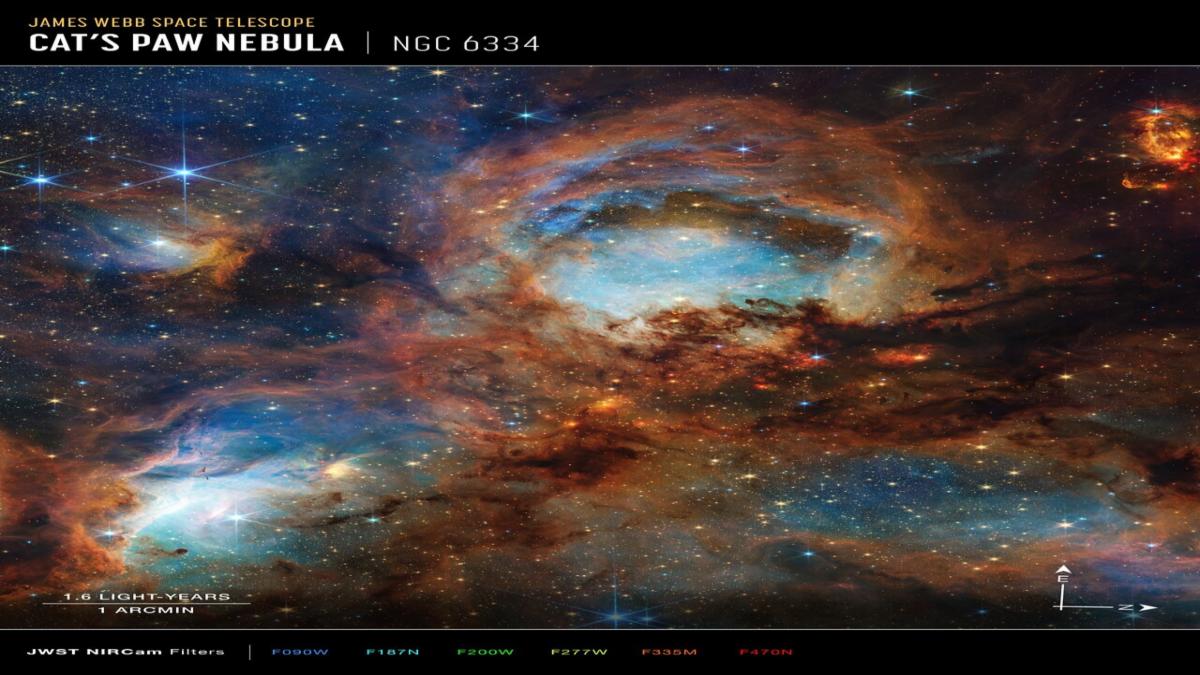Article Body
NASA's James Webb Space Telescope (JWST) has just delivered a breathtaking new image of the Cat’s Paw Nebula (NGC 6334), revealing thick cosmic dust clouds and star-forming regions in unprecedented infrared detail. Released on the telescope's third anniversary, the image is already captivating astronomers and space enthusiasts around the globe.
The reveal marks a major milestone in NASA's continuing quest to explore the early universe and the lifecycle of stars.
🕒 Timeline of Events: JWST’s Cosmic Reveal
-
July 10, 2025 – 10:00 AM (EDT): NASA and ESA released the new image via the official NASA JWST portal and social media channels.
-
10:15 AM: Scientists confirm the nebula is located 5,500 light-years away in the constellation Scorpius.
-
10:30 AM: NASA explains the “clawed back” term — a reference to JWST peeling through cosmic dust to show star births.
-
10:45 AM: Global media outlets and observatories begin sharing interpretations and expert commentary.
📢 Official Sources and Confirmation
“This image showcases the power of infrared astronomy. The James Webb Telescope can see through dust that previously obscured some of the most important star-forming regions in our galaxy.”
— Dr. Mark Clampin, Director, NASA Astrophysics Division
🕓 Source: NASA Press Briefing, July 10, 2025, 10:30 AM EDT
Verified Sources:
-
@NASAWebb (Twitter/X)
🌌 What’s the Impact of This Discovery?
-
Scientific: Offers deeper insight into how massive stars form inside dense clouds.
-
Educational: Provides new data for researchers, educators, and space missions.
-
Public Engagement: Sparks renewed global interest in space science and JWST’s mission.
This release may also influence curriculum updates in astrophysics and space education globally.
🌍 Social Media Reaction
-
The hashtag #CatsPawNebula is trending worldwide on X (formerly Twitter).
-
Astrophotographers and educators are already using the image in educational infographics.
-
One user @AstroGirl90 wrote:
“Webb does it again! I’m in awe. This makes me want to study the stars all over again. #JamesWebb #NASA”
🛡️ What Should You Do Now?
If you’re an astronomy enthusiast, educator, or student:
-
📥 Download the image and analysis from NASA’s official page.
-
🧑🏫 Use the release in classrooms and discussions on infrared astronomy.
-
📱 Follow NASA’s social media handles for live Q&A and image breakdown sessions.
🔭 What Happens Next?
-
July 11, 2025: A detailed scientific paper on this new data will be published in The Astrophysical Journal.
-
Upcoming Weeks: JWST is expected to image other regions within the Milky Way’s star-forming zones, including the Trifid and Eagle Nebulae.
-
NASA has hinted at an upcoming public livestream with real-time astronomer commentary on the nebula structure.
❓ FAQs About the Cat’s Paw Nebula Update
What happened today?
NASA released a new JWST image of the Cat’s Paw Nebula, revealing hidden star nurseries via infrared technology.
Where is the Cat’s Paw Nebula?
It’s located around 5,500 light-years away in the Scorpius constellation.
Why is this image important?
It helps scientists study how stars form in dense clouds — a process vital to understanding the evolution of galaxies.
Is this part of a bigger mission?
Yes. The release marks JWST’s third operational anniversary, with many new observations planned.
Where can I view or download the image?
Visit nasa.gov/webb or follow @NASAWebb on X for high-res versions and explanations.
📌 Final Summary – The Situation So Far
NASA’s James Webb Space Telescope has once again stunned the world with a vivid image of the Cat’s Paw Nebula, offering unparalleled insight into deep space and stellar birth. The release is both a scientific milestone and a celebration of three years of Webb's unmatched cosmic observations. More details and educational breakdowns are expected in the coming days.

Comments